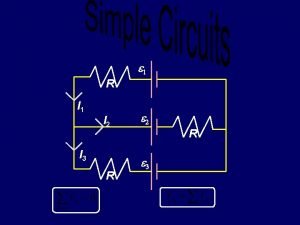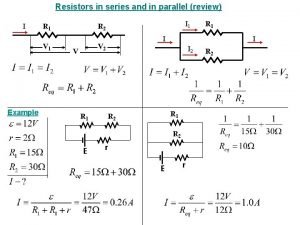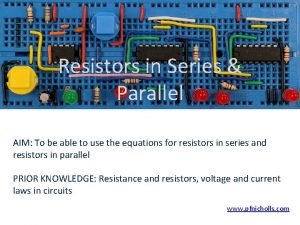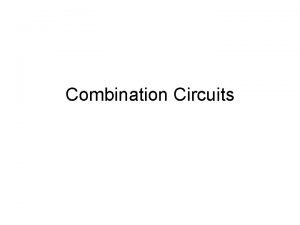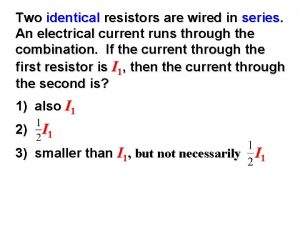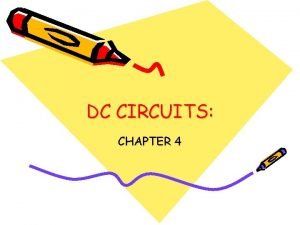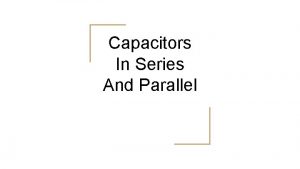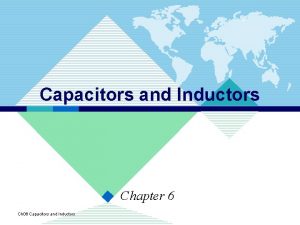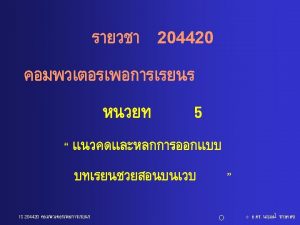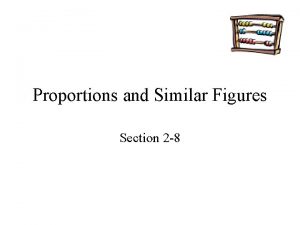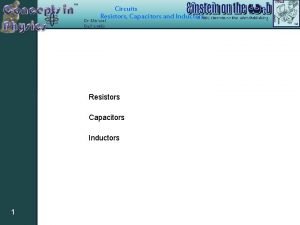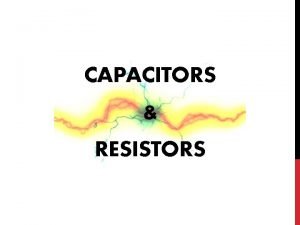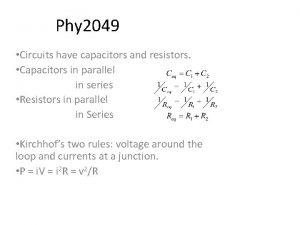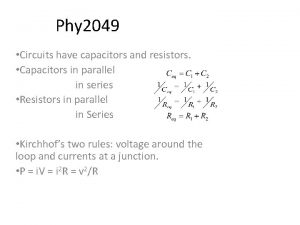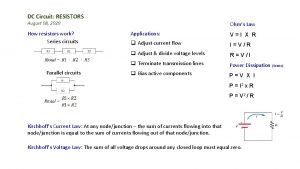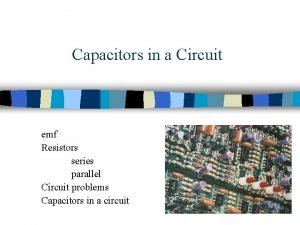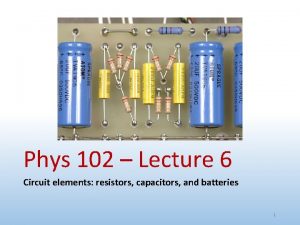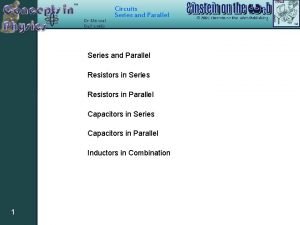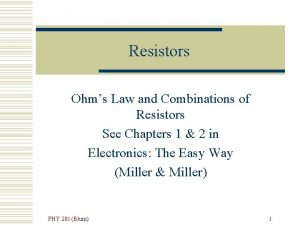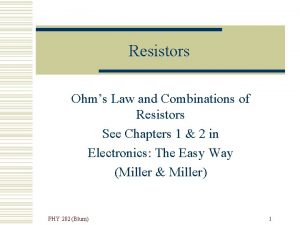Resistors and Capacitors in the Same Circuit RC














- Slides: 14

Resistors and Capacitors in the Same Circuit!! R-C CIRCUITS

Previous assumptions and how they are changing. So far we have assumed resistance (R), electromotive force or source voltage (ε), potential (V), current (I), and power (P) are constant. When charging or discharging a capacitor I, V, P change with time, we will use lowercase i, v, and p for the instantaneous values of current, voltage, and power.

An ideal source (r=0) R - C in Series Initial conditions ε a S b R c C At time t=0 we will close the switch. The instantaneous current at this time is i=0 and the instantaneous charge on the capacitor is q = 0 because at this instant there has been no chance for charge to build on the capacitor…yet!

R - C in Series Charging the Capacitor ε S i=0 a R +q -q b C At time t=0, Vbc = 0, So Vab = ε Therefore, at t=0, c Remember: Current through a series circuit is the same through all parts. Total voltage input is equal to the sum of the voltage drops. As capacitor C charges, Vbc , so Vab , Which causes I , so…

R - C in Series Charging the Capacitor ε S i=0 a R After a long time C will be fully charged and i = 0, so Vab = 0 and Vbc = ε +q -q b C During charging… let q be the charge on the capacitor, and i be the current at any time t Choose “+” current for a “+” charge on the left capacitor plate… c At any time t, instantaneous voltages across the resistor and capacitor are… Vab = i. R and Vbc =q/C

R - C in Series Using Kirchoff’s Law ε S i=0 a R Remember: As q , q/RC zero. When i=0, … +q -q b C c Then solve for i… At t=0, q=0 so initial current I 0 = ε/R. , capacitor charge approaches final Qf and i so… to

ε S i=0 a R R - C in Series Now for the Calculus! +q -q b C c Rearrange equation to put all terms with q on one side and everything else on the other… Now integrate both sides… Use “u-substitution” to evaluate the integral… Eliminate the “ln”…

R - C in Series Results of the Calculus! ε S i=0 a R +q -q b C c At any time t during the charging, the instantaneous charge is… To find the instantaneous current, remember that i = dq/dt

R - C in Series The Graphs i Io Io/2 Io/e q RC t Q f Qf/e Qf/2 RC

What is so special about time = RC? When time t=RC (yes…the product of resistance and capacitance)… Or about 37% of the original current Or about 63% of the original voltage The product of R and C is called the time constant of the circuit. The time constant is a measure of how fast the capacitor charges. The symbol for time constant is τ (greek letter “tau”). It is calculated as RC because a that time the exponent of the “e” function becomes “-1” which gives us the equations above. At t=10τ, I = 0. 000045 I 0 or current is approximately zero. NOTE: If the time constant is small, the capacitor will charge quickly. If the resistance is small, current is small, so the capacitor charges more quickly. If the time constant is large, it will take more time for the capacitor to

R-C Circuits the capacitor Remove battery Discharging to S discharge capacitor Assume the capacitor, C, is fully charged, Q 0 +Q 0 -Q 0 a R b C c Initial Conditions at time t=0…. At t = 0, close the switch… and

R-C Circuits Finding the instantaneous charge during capacitor discharge S i i a R Assume the capacitor, C, is fully charged, Q 0 +q -q b C c The time-varying current, i, … Now integrate and solve for q(t)

R-C Circuits Finding the instantaneous current during capacitor discharge S The time-varying charge, q, … i i a R RC +q -q b C c t q Qo Io/e Io/2 Qo/e Io i RC t

R-C Circuits Energy & Power During charging… The power of the battery, resistor and capacitor are as follows… So…the total power of the circuit is… Where ½ the energy is stored in the capacitor and the other ½ is dissipated by the resistor.
 Two cylindrical resistors are made from the same material
Two cylindrical resistors are made from the same material Resistors in series and parallel
Resistors in series and parallel Resistors in series and parallel equations
Resistors in series and parallel equations Simplifying resistors
Simplifying resistors Identical resistors
Identical resistors A package contains 12 resistors 3 of which are defective
A package contains 12 resistors 3 of which are defective Intrinsic semiconductor
Intrinsic semiconductor Walmart resistors
Walmart resistors Current and inductance relationship
Current and inductance relationship Voltage across capacitors in series
Voltage across capacitors in series I = c dv/dt example
I = c dv/dt example Same place same time
Same place same time Same place same passion
Same place same passion Similar
Similar Similar triangles and polygons
Similar triangles and polygons
